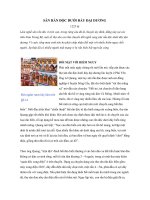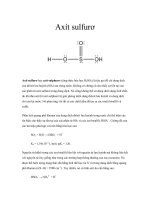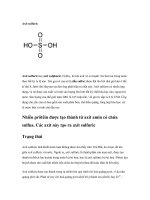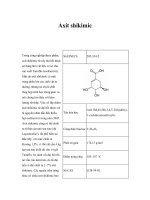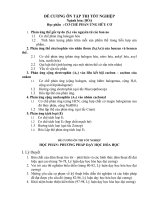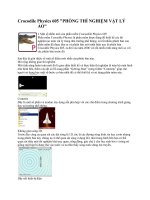- Trang chủ >>
- Khoa Học Tự Nhiên >>
- Vật lý
Tài liệu Quantum Physics doc
Bạn đang xem bản rút gọn của tài liệu. Xem và tải ngay bản đầy đủ của tài liệu tại đây (338.53 KB, 28 trang )
GENERAL PHYSICS III
GENERAL PHYSICS III
Optics
&
Quantum Physics
What
What
does we learn in Gen. Phys. III?
does we learn in Gen. Phys. III?
Many physical phenomena of great practical interest to engineers,
chemists, biologists, physicists, etc. were not in Gen. Phys. I & II
Wave phenomena of light:
Interference: what happens when two or more waves overlap?
(Light passing through two slits give such kind of picture)
Interference!
Quantum Physics:
The development of experimental equiment and techniques
modern physics can go inside the microscopic world (atoms,
electrons, nucleus, etc.)
New principles, new laws for the microscopic (subatomic)
world were discoverved
• Diffraction: The image of an object is not
exact in fine details.
For example, the image of a
circular disk is diffused
Interference & diffraction can be
analyzed if we regard light as a wave
The basis concept: wave particle duality
Examples: light wave photon
electron electron wave etc…
• Subatomic objects obey new mechanics:
quantum mechanics
On the basis of quatum mechanics we study structure and
properties of atoms, nucleus, solids, laser rays, etc…
Chapter XVII
Chapter XVII
Interference of light
Interference of light
§1. Interference of coherent sources of light
§2. Interference in thin films
§3. Interferometer
§1. Interference of light from coherent sources:
We consider an overlap of light that comes from two sources.
A remarkable phenomen takes place, if two sources satisfy some
following conditions:
The sources are
monochromatic.
It means that they emit light
of a single color.
A monochromatic light corresponds to a
sinusoidal electromagnetic
wave
with a single frequency
f
and wave length
Two sources have the same frequency f (the same wave length )
Two souces are permanently
in phase
, or , at least, have any definite
constant phase difference
Then, two sources are called coherent sources.
1.1 Coherent sources of light:
Recall the formula for a sinusoidal e-m wave:
2
, cos cos 2 cos
speed amplitude
2
wavelength wavenumber or wavevector
frequency 2 angular frequency
y x t A x vt A kx ft A kx t
v A
k
f f
Notes:
Common sources of light do not emit monochromatic light
(single-frequency light)
→ However one can produce approximately monochromatic light:
• by using filters which block all but a very narrow range
of wave length
• by using light from a laser
1.2 Interference
1.2 Interference
of light through narrow
of light through narrow
slits:
slits:
Monochromatic
light source at a
great distance,
or a laser.
Slit pattern
Observation
screen
Young’s experiment on doubledouble slit interferenceslit interference
(Thomas Young performed in 1800)(Thomas Young performed in 1800)
Light (wavelength is incident on a two-slit (two narrow,
rectangular openings) apparatus:
If either one of the slits is closed, a
diffuse image of the other slit will appear
on the screen. (The image will be
“diffuse” due to diffraction. We will
discuss this effect in more detail
later.)
Monochromatic light
(wavelength )
S
1
S
2
screen
Diffraction
profile
I
1
If both slits are now open, we see
interference “fringes” (light and dark
bands), corresponding to constructive
and destructive interference of the
electric-field amplitudes from both
slits.
I
S
1
S
2
Dark fringes
Light fringes
Important quantity: path difference = r
2
- r
1
The light density at the location of observer depends on the
path difference
S
1
S
2
Observer
Light
d
r
1
r
2
A path difference corresponds to a phase difference of
two waves at the observer’s point
One has a simple
One has a simple
formula for the path difference,
formula for the path difference,
,
,
whenwhen the observer is far from sourcesthe observer is far from sources
(Assume 2 sources radiating in phase)
= dsin
When observer distance >> slit spacing
(r >> d) :
d sin
Normal to d
d
Observer
r
d
The corresponding phase difference
at the observer’s point:
= dsin= m
Constructive
Interference
= dsin= (m +
1
/
2
)
Destructive
Interference
m=0
m=1
m=2
m=-1
m=-2
= sin
-1
(md
“lines” of
constructive
interference:
d
I
/d
/d
0
-/d
r
Usually we care about the linear
(as opposed to angular)
displacement y of the pattern
(because our screens are often
flat):
L
y
y = L tan
At observer’s points that satisfy the condition
m m = 0, ±1, ±2, → two waves
are in phase and
reinforce each other,
we say
that there is constructive interference
at these points
If m + 1)→ two waves
cancell each other
→ there is
destructive interference
y m(d)L
y (m +
1
/
2
)(d)L
d
Y L
I
L/d
L/d
0
-L/d
L
The slit-spacing d is often large compared to , so that is small.
Then we can use the small angle approximations to simplify our results:
y = L tan L (in radians)
m = 0, ±1, ±2,
m(d)
Constructive
Interference:
(m +
1
/
2
)(d)
Destructive
Interference:
For small angles: (<< 1 radian)
sin tan (only in radians!)
1. What is the spacing y between fringe maxima on a screen 2m away?
a. 1 m b. 1 mm c. 1 cm
2. If we increase the spacing between the slits, what will happen to y?
a. decrease b. stay the same c. increase
3. If we instead use a green laser (smaller ), y will?
a. decrease b. stay the same c. increase
Example:
Example:
A laser of wavelength 633 nm is
incident on two slits separated by
0.125 mm.
I
S
1
S
2
y
1. What is the spacing y between fringe maxima on a screen 2m away?
a. 1 m b. 1 mm c. 1 cm
2. If we
increase
the spacing between the slits, what will happen to y
?
a. decrease b. stay the same c. increase
3. If we instead use a green laser (smaller ), y will?
a. decrease b. stay the same c. increase
Example
Example
(continue)
(continue)
A laser of wavelength 633 nm is
incident on two slits separated by
0.125 mm.
First question: can we use the small angle approximation?
d = 125 m; = 0.633 m d >> is small
d sin
i
= m
i
~ d
i
i
m
i
(d)
y L(
2
–
1
) L(2 – 1) (d) = L/d = (2 m)(0.663 m)/125 m = 0.01 m
S
1
S
2
y
1. What is the spacing y between fringe maxima on a screen 2m away?
a. 1 m b. 1 mm c. 1 cm
2. If we
increase
the spacing between the slits, what will happen to y
?
a. decrease b. stay the same c. increase
3. If we instead use a green laser (smaller ), y will?
a. decrease b. stay the same c. increase
Example
Example
(continue)
(continue)
A laser of wavelength 633 nm is
incident on two slits separated by
0.125 mm.
S
1
S
2
y
Since y ~ 1/d, the spacing decreases. Note: This is a general phenomenon
– the “far-field” interference pattern varies inversely with slit dimensions.
Since y ~ , the spacing decreases.
Note:
If a monochromatic source is replaced by a white light one →
how is the interference picture?
We have known that the location of (light or dark) fringers depends
on the wavelength therfore
• At y = 0 (the center light fringer) the maxima for all wavelengths
coincide → there is a white light fringer
• The nearby fringers have spectrum colors (like in rainbow)
• Far fringers are not visible (are diffused)
§2. Interference in thin films:
This kind of interference takes place when light reflects from a
thin film (for example, a soap bubble, a thin layer of oil floating
on water)
In this case there is an overlap
of light waves: one is reflected
from the upper, the other from
the lower surface.
2.1 Calculation of path difference of two light waves:
First we consider the case that the incident light is monochromatic
with the wavelength
eye
b: the thickness of the film
n: the index of refraction
the path difference between
the reflected waves 1 & 2
By elementary geometry it is
not difficult to obtain
Using the formula one can eliminate i
1
or i
2
We must take into account one more effect: the phase shift of
a wave after reflection
Remark:
The path difference of two reflected waves depends on b, i
1
(or i
2
)
At the points that satisfy m (m = 0, ±1, ±2, ) → we have
cnstructive interference
At the points that satisfy = (m+1/2)→ destructive interference
We use the follwing theoretical results from Maxwell’s theory of
electromagetism:
• If n
a
> n
b
→ the phase shift of
reflected wave relative to the incident
wave is zero
• If n
a
< n
b
→ the phase shift of
reflected wave relative to the incident
wave is radian ( a half cycle)
n
a
n
b
We can take into account this phase shift by introducing a
complementary term in the formula of path difference
2.2 Interference on a film with two parallel surfaces:
(here b = constant)
lens
screen (at the
focus of lens)
Light waves that have the same incident angle i
1
’ ( i
2
’’ ) converge
at P’ (P’’ )
Recall the formula
there will be constructive or destructive interference that depends
on incident angles i
1
→ the interference picture will be light & dark
rings centered at O. It’s called interference rings with the same
inclination
2.3 Interference on a thin wedge:
→ There is interference between
two light rays 1 & 2, reflected
from the upper & the lower
sides, at the points of thickness b.
Shine a beam of parallel light
rays on a thin wedge
Interference takes place also for
light reflected at other points, for example, between the rays 1’ & 2’.
With small angles we can use the previous formula for the path
difference
There will be constructive or destructive interference that depends
on the thickness b at reflected points. On the screen we have light &
dark interference fringers. These are called interference fringers
with the same thickness.
2.4 Newton’s rings:
• Newton’s rings are an example of interference
fringers with the same thickness
Thick glass plate
with parallel
surfaces
Flat-prominal
lens
• Using a glass plate and a lens
one can create an air wedge
between them
• The incident light is normal to the flat
plane of the lens. One can observe the
interference of light waves reflected
from the air wedge.
•The interference picture is a system of
light & dark rings
Notes:
Interference fringers with the same inclination are observed
under the conditions: b = const; incident angles i vary.
Interference fringers with the same thickness are observed
under the conditions: i = const (parallel beam); b varies.
If the light is white → the fringers have rainbow colors
Under real conditions, when you observe a soap bubble or a thin
layer of oil floating on water, you see bands of color → these are
interference fringers mixing of both types (incident angles &
thickness of films can both vary.
Interference on thin film has many application in engineering,
for example, to check the quality of processing surfaces of
material.
Beam
splitter
Monochromatic
source
Compensator
plate
§3. Interferometer:
Interferometer is
a device that uses
interference for
various applications.
The principal components
of a Michelson interferometer:
• Beam splitter P
1
: A glass plate
with a thin coating of silver
→ Light can reflect on and
pass through it.
• Compensator plate P
2
: A plate identical to P1, but without silver layer.
It’s role is to ensure that rays 1 &2 pass through the same path inside
glass (by 3 times of thickness of one plate).
Observer

